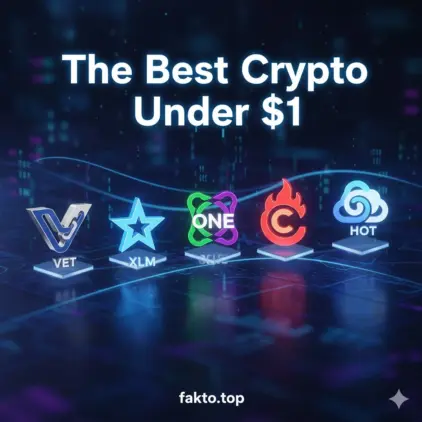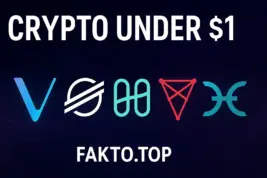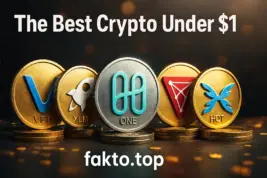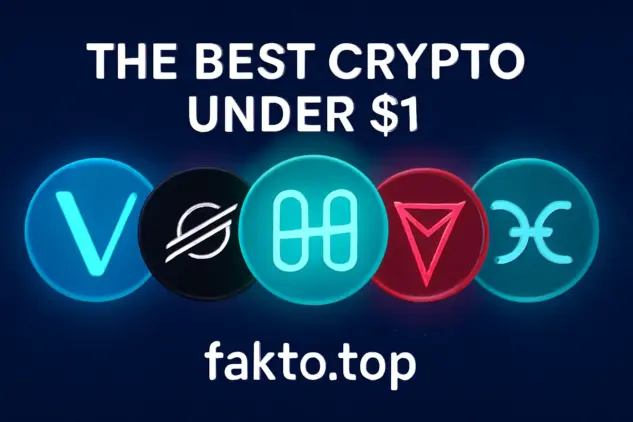The Best Crypto Under $1: 5 Promising Coins to Watch in 2026
The Best Crypto Under $1 to Watch in 2026: A Detailed Guide
There’s something undeniably exciting about the idea of buying cryptocurrencies when the prices are low. The thought of turning a small investment into something much bigger is what draws many newcomers to the crypto world. But here’s the reality: while the potential for massive returns is there, the risks are just as high. This guide isn’t about throwing out “hot tips” or promises of instant riches—it’s about helping you find projects with real value and understanding the true risks behind those tempting price tags.
First things first: the price per coin is often the most misleading metric. Sure, a coin priced at $0.50 might look like a steal, but it’s the market capitalization that reveals the real picture. That’s the number to pay attention to. A $1 coin with a low supply might have far more potential than a $0.10 coin with billions of tokens in circulation. Understanding market cap is key to making informed decisions, and we’ll break it all down for you.

Disclaimer: Not Financial Advice (NFA). The information in this article is for educational purposes only. Cryptocurrencies are a high-risk, volatile asset class. You could lose all your invested capital. This is not financial advice. Please do your own research (DYOR) before investing.
The “Price Trap”: Why Most Crypto Under $1 Isn’t Really “Cheap”
When you see a coin priced under $1, it can be tempting to think it’s a bargain. But don’t get fooled by price alone—it’s not always what it seems. Let’s break it down:
Imagine a $0.10 coin with a circulating supply of 100 billion tokens. That puts the market cap at $10 billion. Now, compare that with a $1,000 coin with only 1 million tokens in circulation. Even though the $1,000 coin seems expensive, its market cap is only $1 billion—far lower. What does this tell us? A lower-priced coin isn’t always “cheaper”—market cap, not price, is what matters.
And don’t forget the circulating supply. A huge supply is why the price per token is so low; the real risk is misunderstanding this dynamic. Coins with massive circulating supplies require billions of new capital to significantly increase their market cap, which makes exponential price movement much harder than many newcomers realize.
How to Research Promising Crypto Under $1: A 5-Point Checklist
So, how do you figure out which low-cost crypto projects are worth your attention? We’ve put together a simple 5-point checklist to help you evaluate each one:
1. Utility & Use Case
Does this token actually do something? A good project should have a real-world application—whether it’s used to pay for network fees, govern a protocol, or power a game. If it doesn’t solve a problem, it might not be worth your time.
2. Tokenomics
Is the coin inflationary or deflationary? Are tokens locked for the team or early investors? The supply dynamics can make or break a coin’s long-term viability. Coins with a high supply and no clear tokenomics can quickly spiral out of control.
3. The Team & Roadmap
Who’s behind the project? Is the team doxxed (i.e., publicly known)? Do they have a solid track record? A strong team with a clear, achievable roadmap is a huge plus. If they’re promising the world but don’t have the skills to back it up, it’s a red flag.
4. Community & Socials
Is there an engaged, active community around the coin? A project’s success is often tied to its community. If all you see are bots and empty promises, that’s a sign to steer clear.
5. Exchange Listings
Where can you buy it? Is it listed on major exchanges like Coinbase or Binance, or is it only available on obscure DEXs (decentralized exchanges)? Being on reputable platforms adds legitimacy to a project.
Top 5 Promising Cryptocurrencies Under $1 to Watch in 2026
Based on the criteria above, we’ve identified 5 projects (as of late 2025) that stand out for their utility, strong fundamentals, and active development.. These coins aren’t just about hype—they have something real to offer. Keep in mind, this list is for educational purposes, not investment advice. Always do your own research (DYOR).
1. VeChain (VET)
What It Is: VeChain is a blockchain platform focused on supply chain logistics, making it easier for businesses to track and authenticate goods in real time. It uses blockchain to bring transparency and efficiency to industries like retail, automotive, and healthcare.
Why It’s Under $1: VeChain has a high circulating supply, which keeps its price low despite its solid use case. Its market cap is substantial, but it’s still priced under $1 due to the large supply of tokens.

The Bull Case (Potential): VeChain’s partnerships with major corporations (such as BMW and Walmart China) make it a strong contender in the supply chain blockchain space. With growing interest in supply chain optimization, VeChain’s utility could drive adoption in 2026 and beyond. Its clear use case and widespread adoption are key factors for potential growth.
The Bear Case (Risks): The market for blockchain solutions in supply chains is still maturing, and there is competition from other projects in this space. Additionally, scaling in a complex, highly-regulated industry like supply chain logistics presents risks that could delay mass adoption.
Where to Buy: Available on Binance, Coinbase, KuCoin.
2. Stellar (XLM)
What It Is: Stellar is a decentralized payment protocol designed to facilitate cross-border payments. It aims to connect financial institutions and drastically reduce the costs and time associated with international transactions.
Why It’s Under $1: Stellar’s price is kept low by its relatively large token supply. However, its strong partnerships with financial institutions such as IBM and its continuous updates make it a solid player in the cross-border payments industry.

The Bull Case (Potential): Stellar’s technology is well-positioned to disrupt the traditional financial sector by offering faster, cheaper cross-border payments. As the world moves toward digital finance, Stellar’s integration into the global payment system could give it significant upside in the coming years.
The Bear Case (Risks): Stellar faces stiff competition from both traditional financial institutions and other blockchain projects targeting cross-border payments. Its adoption and growth will depend heavily on its ability to secure further partnerships and prove itself as a scalable solution.
Where to Buy: Available on Binance, Coinbase, Kraken.
3. Harmony (ONE)
What It Is: Harmony is a fast and secure blockchain that focuses on improving scalability and interoperability between different blockchain networks. It enables cross-chain interactions, making it easier to exchange assets across various platforms.
Why It’s Under $1: Harmony is priced under $1 due to its significant token supply. Despite this, its innovative approach to blockchain scalability and interoperability gives it the potential for long-term success.
The Bull Case (Potential): As the blockchain ecosystem grows, interoperability between different networks will be essential. Harmony’s unique consensus mechanism and focus on cross-chain solutions make it a strong contender in the future of decentralized finance (DeFi). With more developers and platforms building on Harmony, the network’s utility could see exponential growth.

The Bear Case (Risks): The blockchain space is highly competitive, and many projects are also focused on scalability and interoperability. Harmony’s long-term success will depend on its ability to secure key partnerships and maintain a developer-friendly ecosystem.
Where to Buy: Available on Binance, Coinbase, KuCoin.
4. Chiliz (CHZ)
What It Is: Chiliz is a blockchain platform focused on the sports and entertainment industry. It allows sports teams and entertainment brands to create fan tokens that offer fans voting rights, rewards, and exclusive access to content.
Why It’s Under $1: Chiliz is priced under $1 due to its market cap, which is relatively high, but it has yet to reach mainstream adoption. The token’s price remains under $1 despite despite growing interest in fan tokens and sports-related blockchain projects.
The Bull Case (Potential): The sports industry is one of the largest and most lucrative globally. As more sports teams and entertainment brands look for ways to engage with their fan base, Chiliz is well-positioned to lead the way in fan engagement through blockchain technology. The growth of fan tokens and digital collectibles could drive Chiliz’s value in 2026.
The Bear Case (Risks): The market for fan tokens is still relatively niche, and Chiliz faces competition from other blockchain projects targeting the sports and entertainment sector. Additionally, the overall adoption of fan tokens will depend on how quickly sports organizations and fans embrace blockchain technology.
Where to Buy: Available on Binance, Coinbase, Kraken.
5. Holo (HOT)
What It Is: Holo is a decentralized cloud platform that aims to revolutionize the way web applications are hosted. It uses a distributed hash table (DHT) to provide decentralized hosting for peer-to-peer applications, enabling a more efficient and decentralized web infrastructure.
Why It’s Under $1: Holo’s price is kept low due to its large token supply, but it offers a unique and innovative solution to the growing demand for decentralized cloud services. Despite the low price, Holo has a promising use case and a strong development team.
The Bull Case (Potential): As the demand for decentralized applications (dApps) continues to grow, Holo’s decentralized hosting platform could become an essential piece of the web infrastructure. Its ability to offer secure, scalable, and cost-effective hosting for dApps positions it well for future growth.
The Bear Case (Risks): The decentralized cloud hosting market is still in its early stages, and competition from established cloud providers could slow Holo’s adoption. Additionally, Holo’s success depends on the broader adoption of decentralized applications, which is still a work in progress.
Where to Buy: Available on Binance, Coinbase, KuCoin.
Comparative Analysis of Top Picks
| Coin (Ticker) | Category | Price (Oct 2025) | Market Cap (Oct 2025) | 1-Year Price Change (%) | Where to Buy |
|---|---|---|---|---|---|
| VeChain (VET) | Supply Chain | $0.08 | $5B | +15% | Binance, Coinbase, KuCoin |
| Stellar (XLM) | Payments | $0.08 | $4B | +10% | Binance, Coinbase, Kraken |
| Harmony (ONE) | Blockchain Scalability | $0.09 | $1.5B | +25% | Binance, Coinbase, KuCoin |
| Chiliz (CHZ) | Sports & Entertainment | $0.95 | $3B | +40% | Binance, Coinbase, Kraken |
| Holo (HOT) | Decentralized Cloud | $0.011 | $2B | +20% | Binance, Coinbase, KuCoin |
A Step-by-Step Guide: How to Buy Crypto Under $1
Now that you know which cryptos might be worth keeping an eye on, here’s a simple guide to help you get started with buying crypto under $1:
Step 1: Choose a Reputable Crypto Exchange
If you’re just starting, it’s best to use a centralized exchange (CEX) like Coinbase or Binance. These platforms are beginner-friendly, with secure options for buying and storing your crypto. If you’re after more obscure tokens (like some of the ones listed here), you may need to explore decentralized exchanges (DEX) like Uniswap or PancakeSwap—but be aware that these platforms carry higher risks and might be more difficult for beginners.
Step 2: Create & Verify Your Account (KYC)
Before you can buy crypto, you’ll need to create an account and complete a KYC (Know Your Customer) process. This typically involves verifying your identity with documents like a passport or driver’s license. This is a simple but essential step that adds a layer of security to your crypto transactions.
Step 3: Fund Your Account
Once your account is set up, you’ll need to fund it. You can do this through bank transfers, credit or debit cards, or even by transferring cryptocurrency if you already own some. Make sure to check for any fees related to deposits on your chosen exchange.
Step 4: Place Your Buy Order
Now for the fun part! Find the cryptocurrency you want to buy (in this case, under $1), select the amount you want to purchase, and place your order. Most exchanges will allow you to enter the exact amount of crypto you want to buy based on the current market price.
Step 5: Secure Your Coins (Optional but Recommended)
For added security, consider moving your crypto into a private wallet (like Trust Wallet or a hardware wallet like Ledger) if you plan to hold it long-term. Leaving your coins on an exchange exposes them to potential hacking risks, so it’s always a good idea to have control over your private keys if you’re holding crypto for the future.
The Verdict: Is Buying Crypto Under $1 a Good Idea in 2026?
So, is it worth buying cryptocurrencies priced under $1 in 2026? The answer really depends on your approach to investing. If you’re looking for quick gains, the volatile nature of these assets may not be ideal. However, if you’re ready to research, understand the risks, and invest in promising projects with real utility, buying crypto under $1 can be part of a diversified portfolio.
Remember, price isn’t the end-all-be-all. A low-priced coin could still be a bad investment, while a higher-priced coin might offer more long-term potential. The key is to do your due diligence and never invest more than you can afford to lose.
Final Call to Action (CTA): The difference between gambling and investing is research. Use the 5-point checklist in this guide to start your crypto journey. And always remember, investing in crypto carries risks, so never invest more than you’re willing to lose.
Legal Disclaimer: All content on this website is for informational purposes only and does not constitute financial, investment, legal, or tax advice. The authors and the publication are not financial advisors. Investing in cryptocurrencies and other digital assets is highly speculative and carries a significant risk of loss. Past performance is not an indicator of future results. You should always conduct your own research (DYOR) and consult with a qualified professional before making any investment decisions.
